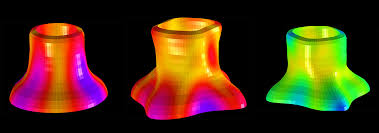The science behind one of UK’s most iconic sounds
A signature sound for Great Britain is the bongs of Big Ben, the giant bell housed within the clock tower of the Houses of Parliament. And tonight it will welcome in the New Year. There is something special about the sound. Listen to a bell chime and what at first seems a simple ring is actually a very complex sound. Why does it start with a clang? Why do the bongs have a dissonant warble?
At the start of the main strike there is a clank of metal on metal as the hammer hits the bell, which gradually fades into a sonorous ringing. While the initial hammer blow creates lots of high frequencies, these rapidly die away, leaving a gentler low frequency ring, which slowly warbles. The start of the note, the attack, is a fleeting moment, but it is incredibly important to identifying what is making the sound.
You can see all these features in the spectrogram below, which shows how the frequency content of the bell sound varies over time. The dark horizontal lines show the frequency components that make up the bongs. At the beginning to the left there are lots of dark lines across all frequencies from top to bottom – that is created by the clank of metal on metal. But the high frequencies have disappeared later as shown to the right. The warble show up as a dashed horizontal line, because that frequency component of the sound keeps fluctuating between quiet and loud.

The warble is created because Big Ben isn’t perfectly circularly symmetric. A large crack opened up on one side shortly after it was first installed because they used a hammer that was too heavy. This asymmetry changes how the bell flexes.
ASDEC (Advanced Structural Dynamics Evaluation Centre)
If you look at the video above and you’ll see a bell (not Big Ben) vibrating. These are the vibration patterns at the various frequencies that make up the bell sound. If a bell is not quite circularly symmetric, you actually get two notes being created that are very close in frequency. These then create beats where you hear a sound that is at an average of the two frequencies, which keeps slowly changes in amplitude from between quiet to loud. The video below has a nice demo about 1:20 into it. Beats is what creates the Big Ben Warble.
You can’t currently visit Big Ben because it is being renovated. But this is what it is like:
“A large 200 kg hammer drew back slowly before crashing forward and striking the outside of the bell. Even with ear plugs in, the sense of power was visceral. The sound resonated the air in my chest like a pumping bass line in a nightclub. “
Sonic Wonderland / The Sound Book.
Big Ben is the iconic sound of New Year for the UK but what is the equivalent in other countries? Please let me know by commenting below.
Acknowledgements
Ben Ben modes: Advanced Structural Dynamics Centre at the University of Leicester
Follow me
0 responses to “Big Ben's Bongs”
Great blog entries this year, Trevor. all the best for 2019.
D
Damian Kearns
217 Yarmouth Road
Toronto, ON
M6G1X5
iPhone: 647.998.0013
damiankearns@hotmail.com
[…] Source link Epic Sound […]
Acoustics is fascinating! Thank you for all posts, especially with the many interesting examples.
I live in Chicago (USA). Like other big cities, we usually have fireworks at Navy Pier on the shores of Lake Michigan. But the first burst doesn’t go off at exactly midnight, and there’s no other loud signal. I used to listen to the BBC World Service on my shortwave receiver, and occasionally I listened to Big Ben on New Year’s. I can still listen to the online streams, of course, but with the inherent delay it isn’t quite the same. Big Ben was the only thing that was anywhere near iconic for me for New Year’s.
Interesting how the imperfection gives the sound the quality we love. If the sound of BB were a face, perhaps W H Auden (-:
More tech note: I was wondering if the freq modulation of higher harmonics by the physical movement of the bell at lower harmonics (ie doppler shift) is significant. Would need to know the amplitudes to do the sums and model the sounds. Some interesting maths here, probably beyond my rusty undergrad stuff from the 70s!